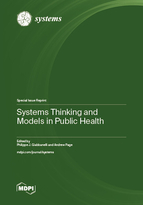Systems Thinking and Models in Public Health
A special issue of Systems (ISSN 2079-8954). This special issue belongs to the section "Systems Practice in Social Science".
Deadline for manuscript submissions: closed (15 August 2023) | Viewed by 22189
Special Issue Editors
Interests: health behaviors; machine learning; modeling; simulation
Special Issues, Collections and Topics in MDPI journals
Special Issue Information
Dear Colleagues,
We are pleased to announce a Special Issue on “Systems Thinking and Models in Public Health”. Systems Thinking and Modeling have been essential approaches to identifying drivers of health outcomes and analyzing their complex interrelationships, hence paving the way to find interventions that improve outcomes while minimizing unintended consequences. These methods support interdisciplinary teams in representing and navigating complex systems, thus asking essential ‘what-if’ questions and serving numerous other goals, from guiding data collection efforts to comparing the perspectives of stakeholders or validating theories. This Special Issue seeks methodological innovations and applications for several determinants and key population global health priority areas.
Priority determinants include, but are not limited to, social determinants (e.g., with respect to health inequalities), climate change (through its impact on health), behavioral factors, and facets of the healthcare system ranging from primary services to secondary prevention (i.e., screening and case-finding) and tertiary case (e.g., treatment optimization, resource allocation). Systems thinking and modeling can shed light on how such determinants ultimately shape health outcomes and/or the cost-effectiveness of an intervention. Although the reduction of any disease burden is of interest, we highlight the importance of seven categories as global health priority areas: cardiovascular diseases, cancer, mental health, injury, diabetes, respiratory diseases, and maternal and neonatal disorders. As a Special Issue showcasing the latest developments in research, we also welcome contributions on novel topics. While COVID-19 models are already aptly handled by other Special Issues, note that long COVID would exemplify emerging applications of interest for global health.
All submissions should strive to justify the selection of their methods and promote transparency in their application. For example, best practices in participatory modeling suggest that there are clear processes to identify and engage stakeholders (e.g., community members, public health experts, clinicians, decision-makers). Cases that either produce systems maps (e.g., causal loop diagrams, mind maps) and models (e.g., system dynamics, agent-based models, network models, fuzzy cognitive maps) or analyze them to prioritize interventions should thus be explicit in their participatory design and analytical approach.
We note that there are several methodological open problems in the application of systems science and modeling to public health, hence submissions may contribute to addressing these gaps through their case studies or methodological novelty. Three aspects are of particular interest when submissions emphasize methodological innovations. First, we acknowledge that systems thinking and models are essential tools to identify interventions, but their value is much broader than providing predictions. Indeed, models also serve to learn about a phenomenon and to guide productive discussions that are not limited by disciplinary boundaries. Innovations can thus contribute to the study of models as vehicles to facilitate knowledge translation. Second, models can serve the dual role of identifying and evaluating interventions. For example, results from an intervention can be compared with expectations from the model, thus revealing potential discrepancies and bottlenecks. We thus encourage research that embeds models in practices, for instance as part of program evaluation. Finally, we note that data science has permeated virtually every field of research, and public health is no exception. Opportunities (e.g., for calibration, verification and validation) and challenges (e.g., uncertainty) in the use of data can thus contribute to advancing the field.
We solicit papers for this Special Issue that broadly deal with such challenges by addressing open questions, providing novel case studies, or leading to interesting and challenging debates. Papers can be reviews, syntheses, viewpoints, meta-analyses, or original research articles.
Dr. Philippe J. Giabbanelli
Prof. Dr. Andrew Page
Guest Editors
Manuscript Submission Information
Manuscripts should be submitted online at www.mdpi.com by registering and logging in to this website. Once you are registered, click here to go to the submission form. Manuscripts can be submitted until the deadline. All submissions that pass pre-check are peer-reviewed. Accepted papers will be published continuously in the journal (as soon as accepted) and will be listed together on the special issue website. Research articles, review articles as well as short communications are invited. For planned papers, a title and short abstract (about 100 words) can be sent to the Editorial Office for announcement on this website.
Submitted manuscripts should not have been published previously, nor be under consideration for publication elsewhere (except conference proceedings papers). All manuscripts are thoroughly refereed through a single-blind peer-review process. A guide for authors and other relevant information for submission of manuscripts is available on the Instructions for Authors page. Systems is an international peer-reviewed open access monthly journal published by MDPI.
Please visit the Instructions for Authors page before submitting a manuscript. The Article Processing Charge (APC) for publication in this open access journal is 2400 CHF (Swiss Francs). Submitted papers should be well formatted and use good English. Authors may use MDPI's English editing service prior to publication or during author revisions.
Keywords
- agent-based models
- computational epidemiology
- modeling and simulation
- participatory modeling
- population health
- public health informatics
- systems maps







